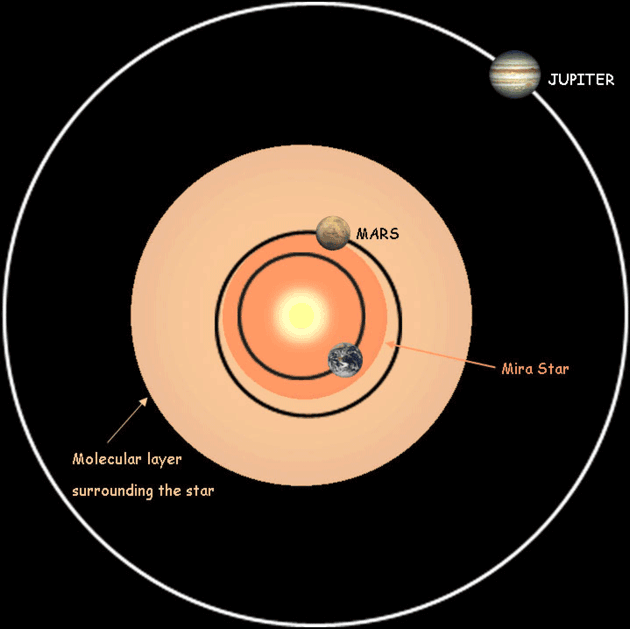Glimpse at Swollen Stars Hints at Earth's Demise

Today's global warming is nothing compared to what astronomers have just seen through the time machine of a telescope.
The most detailed look ever at the environments very near the surfaces of several aging and bloated stars reveals a potentially red-hot future for Earth. Because the stars are older versions of the one that gives us warmth, the measurements help astronomers envision what will happen in a few billion years, when the swollen Sun will scorch Earth.
The dying objects are called Mira stars, for one of the most famous of the bunch. They are part of a broader class of object known as red giants, which include the popular skywatching targets Betelgeuse (often pronounced "beetle juice") and Antares, both considered red supergiants.
Mira stars have nearly exhausted the hydrogen that powers their thermonuclear furnaces. Each is swelled to a diameter that is larger than the orbit of our home planet. The aging stars pulsate, expanding and contracting every year or so.
When our Sun begins to pulsate, the surface temperature on Earth will periodically climb to 5,400 degrees Fahrenheit (3,000?C), said Guy Perrin, a Paris Observatory researcher who led the new study.
"The direct consequence is that no life will be possible by then on Earth," Perrin told SPACE.com . "But this is in a few billion years from now."
It is also one reason why Perrin and his colleagues eagerly study Mira stars, whose intense activity has prevented views of their surfaces.
Get the Space.com Newsletter
Breaking space news, the latest updates on rocket launches, skywatching events and more!
The new work combined several telescopes to effectively create one large observatory in a technique called interferometry, allowing a look at each stars photosphere, the area just above the surface.
"During these pulsations, Mira stars lose a lot of mass to the interstellar medium," Perrin explained. Material equal to about a third of the Earth is pumped into interstellar space with each pulsation. Scientists don't know exactly how all this works.
"The current belief is that pulsations levitate material above the surface, and this material forms dust, which is pushed away by the radiation from the star like a wind," he said.
Behind the wind is a star surrounded by a shell of water vapor and possibly carbon monoxide, the new research found. The presence of this layer, far above the stellar surface, is "somewhat mysterious," Perrin's team reports. It is too high and dense to be supported purely by atmospheric pressure, they say. The pulsations of the star probably have something to do with it.
The researchers were also able to pin down some dimensions. Mira stars are about 30 percent smaller than previous observations had suggested. The surface diameter of each corresponds to a diameter just inside the orbit of Mars. The outer layer of water vapor and carbon monoxide, however, is as far from the stars' centers as the asteroid belt -- between Mars and Jupiter -- is from our Sun.
"This discovery resolves nagging inconsistencies between observations of the size of Mira stars, and models describing their composition and pulsations, which now can be seen to generally agree with each other," said team member Stephen Ridgway of the National Optical Astronomy Observatory in Tucson, Arizona.
And here's what it means in the long run: When our Sun swells, Earth will be engulfed and vaporized and Mars will be seared. One of the remaining questions, on which other scientists have speculated, is whether life on Earth will end due to extreme drought or wait to be utterly fried.
The near-infrared observations were made with the Infrared-Optical Telescope Array (IOTA) of the Smithsonian Astrophysical Observatory in Arizona. The results will be published in the journal Astronomy & Astrophysics.
- Earth's Fate as Sun Swells
- Recipe to Save Earth: Move It
Join our Space Forums to keep talking space on the latest missions, night sky and more! And if you have a news tip, correction or comment, let us know at: community@space.com.

Rob has been producing internet content since the mid-1990s. He was a writer, editor and Director of Site Operations at Space.com starting in 1999. He served as Managing Editor of LiveScience since its launch in 2004. He then oversaw news operations for the Space.com's then-parent company TechMediaNetwork's growing suite of technology, science and business news sites. Prior to joining the company, Rob was an editor at The Star-Ledger in New Jersey. He has a journalism degree from Humboldt State University in California, is an author and also writes for Medium.









